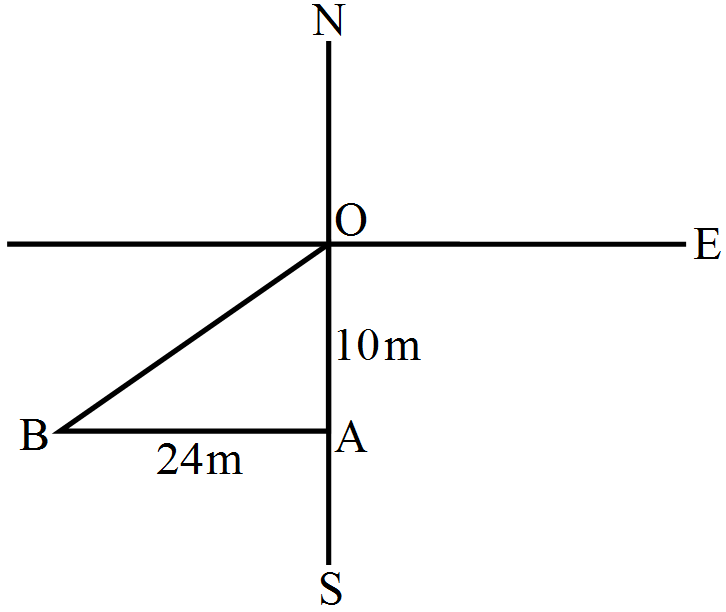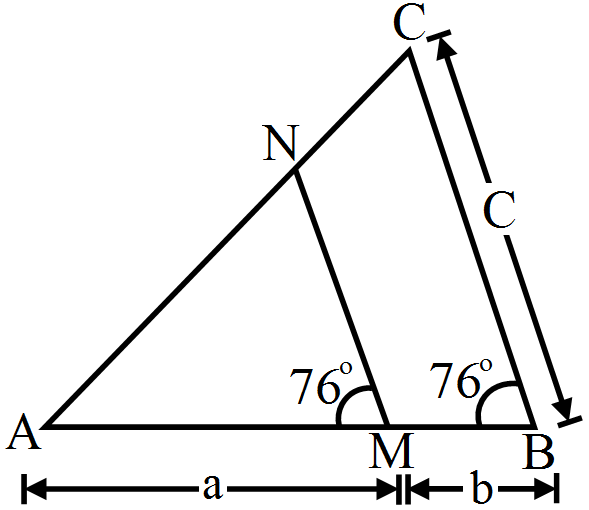A man goes $10\ m$ due south and then $24\ m$ due west. How far is he from the starting point?
starting from O, let the man goas from O to A and then A to B as shows in the figure.
Then, $\text{OA}=10\text{m},\text{AB}=24\text{m }$ and $\angle\text{OAB}=90^\circ$

Using Pythagoras theorem:
$OB^2 = OA^2+AB^{2}$
$ \Rightarrow OB^2= 10^2 + 24^{2}$
$ \Rightarrow OB^2 = 100 + 576$
$\Rightarrow OB^2 = 676$
$\Rightarrow\text{OB}=\sqrt{676}=26\text{m}$ Hence, the man is $26\ m$ south-west from the starting position.
Then, $\text{OA}=10\text{m},\text{AB}=24\text{m }$ and $\angle\text{OAB}=90^\circ$

Using Pythagoras theorem:
$OB^2 = OA^2+AB^{2}$
$ \Rightarrow OB^2= 10^2 + 24^{2}$
$ \Rightarrow OB^2 = 100 + 576$
$\Rightarrow OB^2 = 676$
$\Rightarrow\text{OB}=\sqrt{676}=26\text{m}$ Hence, the man is $26\ m$ south-west from the starting position.
Download our appand get started for free
Experience the future of education. Simply download our apps or reach out to us for more information. Let's shape the future of learning together!No signup needed.*
Similar Questions
- 1View SolutionFind the lenght of each side of a rhombus whose diagonals are 24cm and 10cm. long.
- 2In the given figure, $\angle\text{CAB}=90^\circ$ and $\text{AD}\perp\text{BC}.$ Show that $\triangle\text{BDA}\sim\triangle\text{BAC}.$ If AC = 75cm, AB = 1m, and BC = 1,25m find AD.View Solution

- 3The corresponding sides of two similar triangles are in the ratio $2 : 3.$ If the area of the smaller triangle is $48\ cm^2,$ find the area of the larger triangle.View Solution
- 4View SolutionThe sides of certain triangles are given below. Determine them are right triangles:
1.6cm, 3.8cm, 4cm. - 5In $\triangle\text{ABC},$ the bisector of $\angle\text{B}$ meets AC at D. A line PQ || AC meets AB, BC and BD at P, Q and R respectively.View Solution
Show that PR × BQ = QR × BP.

- 6In the given figure, $DE || BC$. If $DE = 3\ cm$, $BC = 6\ cm$ and $\text{ar}(\triangle\text{ADE})=15\text{cm}^2,$ find the area of $\triangle\text{ABC}.$View Solution

- 7View SolutionThe corresponding altitudes of two similar triangles are 6cm and 9cm respectively, Find the ratio of their areas.
- 8The corresponding sides of two similar triangles are in the ratio $2 : 3$. If the area of the smaller triangle is $48\ cm^2$, find the area of the larger triangle.View Solution
- 9In the given figure, $\angle\text{AMN}=\angle\text{MBC}=76^\circ.$ If p, q and r are the lengths of AM, MB and BC respectively then express the length of MN in terms of p, q and r.View Solution

- 10View SolutionFor the following statments state whether true (T) or false(F):
The ratio of the areas of two similar triangles is equal to the ratio of their corresponding angle-bisector segments.
